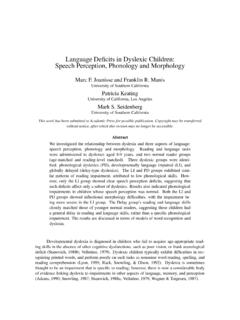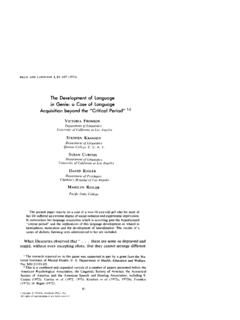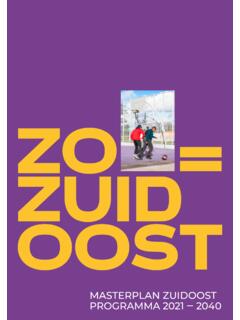Transcription of Introduction to Linguistics
1 Introduction to LinguisticsMarcus KrachtDepartment of Linguistics , UCLA3125 Campbell Hall450 Hilgard AvenueLos Angeles, CA 90095 1: Introduction .. 3 Lecture 2: Phonetics.. 12 Lecture 3: Phonology I..24 Lecture 4: Phonology II.. 41 Lecture 5: Phonology III.. 55 Lecture 6: Phonology IV.. 66 Lecture 7: Morphology I.. 79 Lecture 8: Syntax I.. 86 Lecture 9: Syntax II.. 98 Lecture 10: Syntax III.. 109 Lecture 11: Syntax IV.. 119 Lecture 12: Syntax V.. 134 Lecture 13: Morphology II.. 144 Lecture 14: Semantics I.. 154 Lecture 15: Semantics II.. 160 Lecture 16: Semantics III.. 168 Lecture 17: Semantics IV.. 177 Lecture 18: Semantics V.. 186 Lecture 19: Language Families and History of Languages.. 194 Lecture 1: IntroductionLanguages are sets ofsigns. Signs combine an exponent (a sequenceof letters or sounds) with a meaning.
2 Grammars are ways to generatesigns from more basic signs. Signs combine a form and a meaning,and they are identical with neither their exponent nor with their we have tried to be as explicit as I could in preparing these will find that some of the technicalities are demanding at first sight. Donot panic! You are not expected to master these technicalities right away. Thetechnical character is basically due to my desire to be as explicit and detailed aspossible. For some of you this might actually be helpful. If you are not amongthem you may want to read some other book on the side (which I encourage you todo anyway). However, Linguistics is getting increasingly formal and mathematical,and you are well advised to get used to this style of doing science. So, if you donot understand right away what I am saying, you will simply have to go over itagain and again.
3 And keep asking questions! New words and technical termsthat are used for the first time are typed in bold-face. If you are supposed toknow what they mean, a definition will be given right away. The definition isvalid throughout the entire course, but be aware of the fact that other people mightdefine things differently. This applies when you read other books, for should beware of possible discrepancies in terminology. If you are not givena definition elsewhere, be cautious. If you are given a different definition it doesnot mean that the other books get it wrong. The symbol in the margin signalssome material that is difficult, and optional. Such passages are put in for thosewho want to get a perfect understanding of the material; but they are not requriedknowledge.
4 (End of note)Language is a means to communicate, it is a semiotic system. By that wesimply mean that it is aset of signs. Its Asignis a pair consisting in the wordsof Ferdinand de Saussure of asignifierand asignified. We prefer to call thesignifier theexponentand the signified themeaning. For example, in English thestring/dog/is a signifier, and its signified is, say, doghood, or the set of all dogs.(I use the slashes to enclose concrete signifiers, in this case sequences of letters.)Sign systems are ubiquitous: clocks, road signs, pictograms they all are parts of4 Lecture 1: Introductionsign systems. Language differs from them only in its complexity. This explainswhy language signs have much more internal structure than ordinary signs. Fornotice that language allows to express virtually every thought that we have, andthe number of signs that we can produce is literally endless.
5 Although one mayfind it debatable whether or not language is actually infinite, it is clear that weare able to understand utterances that we have never heard before. Every year,hundreds of thousands of books appear, and clearly each of them is new. If itwere the same as a previously published book this would be considered a breachof copyright! However, no native speaker of the language experiences troubleunderstanding them (apart from technical books).It might be far fetched, though, to speak of an entire book as a sign. Butnothing speaks against that. Linguists mostly study only signs that consist of justone sentence. And this is what we shall do here, too. However, texts are certainlymore than a sequence of sentences, and the study ofdiscourse(which includestexts and dialogs) is certainly a very vital one.
6 Unfortunately, even sentences areso complicated that it will take all our time to study them. The methods, however,shall be useful for discourse analysis as Linguistics , language signs are constituted of four different levels, not justtwo:phonology,morphology, withthe meanings (what is signified), while the other three are all concerned with theexponent. At the lowest level we find that everything is composed from a smallset of sounds, or when we write of letters. (Chinese is exceptional in that thealphabet consists of around 50,000 letters , but each sign stands for a syllable asequence of sounds, not just a single one.) With some exceptions (for exampletone and intonation) every utterance can be seen as a sequence of sounds. Forexample,/dog/consists of three letters (and three sounds):/d/,/o/and/g/.
7 Inorder not to confuse sounds (and sound sequences) with letters we denote thesounds by enclosing them in square brackets. So, the sounds that make up [dog]are [d], [o] and [g], in that order. What is important to note here is that soundsby themselves in general have no meaning. The decomposition into sounds hasno counterpart in the semantics. Just as every signifier can be decomposed intosounds, it can also be decomposed into words. In written language we can spot thewords by looking for minimal parts of texts enclosed by blanks (or punctuationmarks). In spoken language the definition of word becomes very tricky. Thepart of Linguistics that deals with how words are put together into sentences iscalledsyntax. On the other hand, words are not the smallest meaningful units ofLecture 1: Introduction5language.
8 For example,/dogs/is the plural of/dog/and as such it is formed bya regular process, and if we only know the meaning of/dog/we also know themeaning of/dogs/. Thus, we can decompose/dogs/into two parts:/dog/and/s/.The minimal parts of speech that bear meaning are calledmorphemes. Often, itis tacitly assumed that a morpheme is a part of a word; bigger chunks are calledidioms. Idioms are/kick the bucket/,/keep taps on someone/, and so reason for this division is that while idioms are intransparent as far as theirmeaning is concerned (if you die you do not literally kick a bucket), syntacticallythey often behave as if they are made from words (for example, they inflect:/Johnkicked the bucket/).So, a word such as dogs has four manifestations: its meaning, its soundstructure, its morphological structure and its syntactic structure.
9 The levels ofmanifestation are also calledstrata. (Some use the termlevel of representa-tion.) We use the following notation: the sign is given by enclosing the string inbrackets: dog . [dog]Pdenotes its phonological structure, [dog]Mits morpholog-ical structure, [dog]Lits syntactic structure and [dog]Sits semantical structure. Ialso use typewriter font for symbols in print. For the most part we analyse lan-guage as written language, unless otherwise indicated. With that in mind, we have[dog]P=/dog/. The latter is a string composed from three symbols,/d/,/o/and/g/. So, dog refers to the sign whose exponent is written here/dog/. We shallagree on the 1 Asignis a quadruple , , , , where is itsexponent(orphono-logical structure), itsmorphological structure, itssyntactic structureand itsmeaning(orsemantic structure).
10 We write signs vertically, in the following way.(1) This definition should not be taken as saying something deep. It merely fixes thenotion of a linguistic sign, saying that it consists of nothing more (and nothingless) than four things: its phonological structure, its morphological structure, itssyntactic structure and its semantic structure. Moreover, in the literature there are6 Lecture 1: Introductionnumerousdifferentdefinitions of signs. You should not worry too much here: thepresent definition is valid throughoutthis book only. Other definitions have power of language to generate so many signs comes from the fact that ithas rules by which complex signs are made from simpler ones.(2)Cars are cheaper this (2), we have a sentence composed from 5 words. The meaning of each word isenough to understand the meaning of (2).








